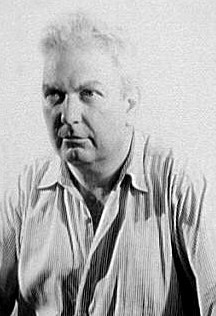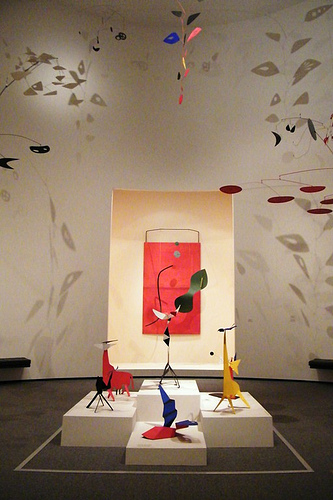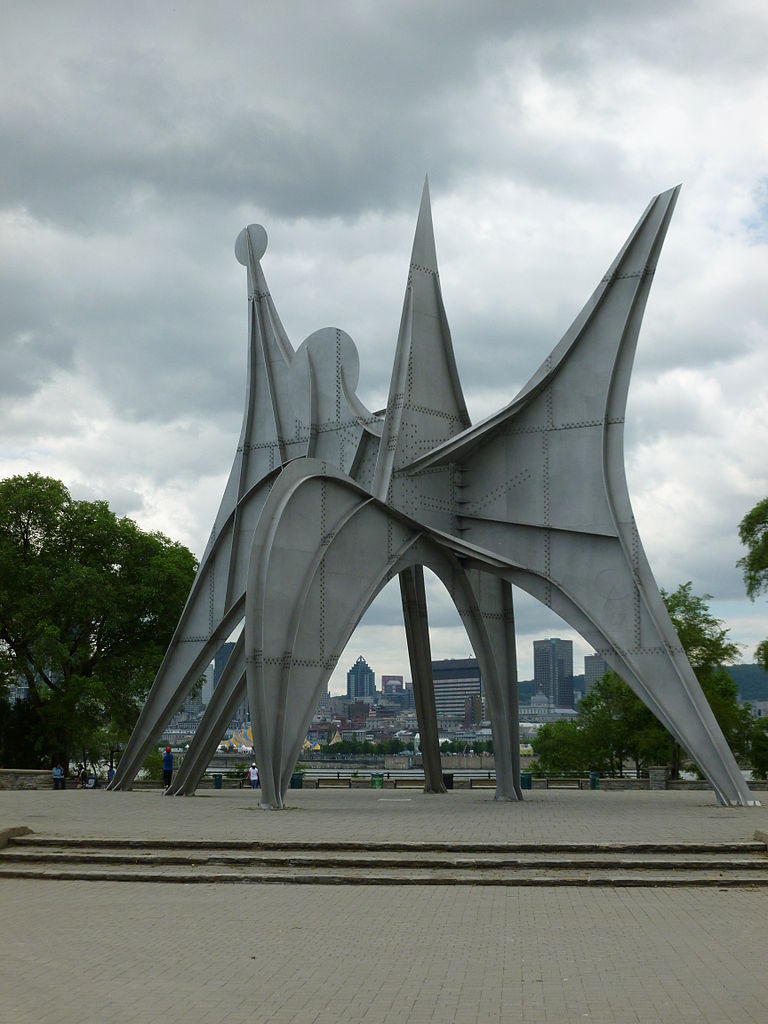| Alexander Calder | |
|---|---|
 |
|
| Born | July 22, 1898 Lawnton, Pennsylvania |
| Died | Nov. 11, 1976 (at age 78) New York City |
| Nationality | American |
| Education | Stevens Institute of Technology, Art Students League of New York |
| Field | Sculpture |
| Famous Works | Calder’s Circus, Josephine Baker I, Man |
Alexander Calder was an American sculptor and artist. He was born in 1898 to an established sculptor, Stiring Calder, in Philadelphia. His grandfather, whom the artist was named after, was also a notable sculptor and artist himself. Calder posed as a model for his grandfather and started creating sculptures while he was still very young. During his teenage years and up to the end of his high school career, Calder’s family lived between New York and California.
Alexander Calder studied engineering in New Jersey. He then worked professionally as an engineer in New York, but this did not last long. The artist began to travel a lot, for both professional and personal reasons. After settling in Washington for a short while, Calder returned to New York in 1922 to work full time as an artist. A year later, Calder joined the Art Student League of New York. During this time, Calder went to see a circus, which became a major inspiration and theme later on his life. A year after he is done with his studies, Calder moved to Paris to establish a small art studio. He continued his studies at the Académie de la Grande Chaumière. During the first few years he lived in Paris, Calder established himself as a popular artist and mingled with many prominent avant-garde Parisian figures.
The Kinect Art Movement
Calder was primarily involved with The Kinect Art movement, however his work was also influenced by many other movements during his time, including cubism, avant-garde, and pop art. Calder’s work was heavily influenced and frequently relied on his engineering background, but this was something that would not be obvious to anyone until later in Calder’s life.
The Circus and the Toys
Alexander Calder started to make toys when he was in Paris. These toys could often be moved by pulling a piece of string. His toys were then mass produced and stocked in various shops. In the meantime, Calder created Cirque Calder. His Cirque Calder was made of many different wires and mechanisms, this piece had to be shown through a performance in which Calder would frequently improvise lines while showing off what all the different wooden circus performers could do.
Cirque Calder became very popular in New York and Paris.
The Rise of “The Mobile”
Cirque Calder was the start of a lifelong obsession for Alexander Calder. He was fascinated by the way wires worked and looked. He sculpted with a keen eye for detail, all while taking into consideration his engineering background, which allowed him to create abstract art that did not only create an illusion of moving but that actually moved. This was done almost by accident: Calder was fascinated with abstract art and wanted to create something that truly epitomized abstract art. After a while, Calder defied the common definition of art as something static and created sculptures which could be changed by moving pulleys and levers.
In doing so, Calder was the one of the first artists to truly integrate change into the common definition of aesthetics and beauty. He also made motion an important part of art and artworks. Calder’s earlier work aims to reconstruct abstract paintings which inspired and awed him in a three-dimensional interpretation. It was during this period that Calder created mobiles. The word mobiles came to symbolize kinetic sculptures that did not need any sort of motor or engine to move, although the word was originally used to encompass and describe any kind of kinetic sculpture.
Playing With Air, Stabiles and the War
Calder began to create more delicate sculptures which took elements from nature like birds and leaves, which often were only mobile because of the environment they were in. He also started to work on self-supporting sculptures, called stabiles.
Stabiles were crafted with metal and, although they did not move, the lines these abstract sculptures had in them often portrayed movement or motion. Later on, Calder continued to sculpt using mostly wood instead of metal.
During World War II, Calder tried to enlist but was turned down. He kept sculpting during the war, but the reality of the period meant that scrap and metal was running low and Calder was driven to produce carved wood works again.
Post-War Work: “Agrandissements”
While Calder continued to create stabiles and mobiles with metal, his reputation grew with an exhibition in Paris that included the participation of Sartre. Calder calls the period after 1950 “agrandissements.” This is because during this period Calder created many huge sculptures in world hubs, some of which have become landmarks. These sculptures were originally created the same way that his other mobiles were, they were intended to flow freely in the wind and breeze with rhythm. Unfortunately these first few outside sculptures that proved to be too frail to withstand the wind and pressure from outside.
His process changed, he started to sketch his mobiles on brown paper and then oversee the recreation of his maquettes with a strong attention to detail. The material used for these huge sculptures was carbon steel sheet metal. These sculptures showed up in important places in the world like the JFK airport and The Sears Tower in Washington. Calder’s WTC Stabile was located in front of the World Trade Center and destroyed on September 11, 2001.
Other Notable Work
In addition to being an accomplished sculptor, Calder created several paintings throughout his career, he designed dance sets and created jewelry. His paintings became abstract when he lived in Paris. He went on to create gouache prints, which became very popular in the 50s and 60s and were mass produced. He was commissioned to paint three airplanes in his lifetime and was working on one before he died in 1976.
Alexander Calder died suddenly in 1976 in New York. His artistic legacy has changed the cultural landscape he worked in and he has helped shaped current public art.

